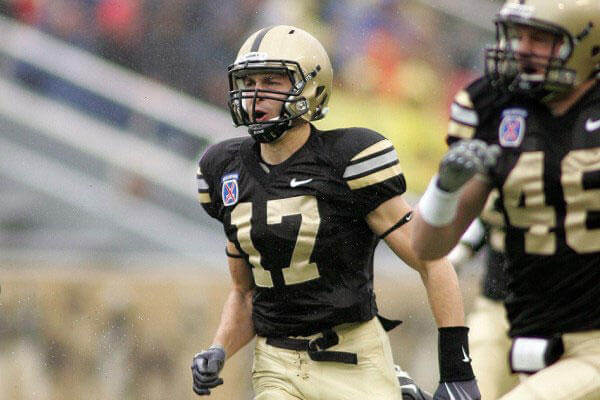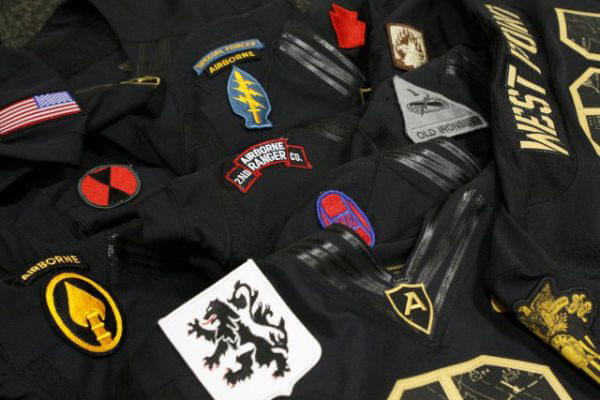The U.S. Naval Academy and U.S. Military Academy football teams will face off Saturday to win bragging rights on the gridiron, but their uniforms will show that the football game is about much more.
Army quarterback Angel Santiago will wear the patch of the 10th Mountain Division, by some counts the most deployed unit in the Army, for the game at M&T Bank Stadium in Baltimore.
Navy defensive lineman Aaron Davis and outside linebacker Obi Uzoma will wear the patch of the amphibious ship New York, whose hull contains steel from the Twin Towers that were hit in the terror attacks of Sept. 11, 2001.
Both teams have a tradition of wearing patches "honoring those who serve worldwide," but the tradition takes on special significance for the annual rivalry game between the two service academies.
Since 9/11, 95 graduates of the U.S. Military Academy at West Point, New York, and 16 from the Naval Academy in Annapolis, Maryland, have been killed in Iraq and Afghanistan.
Most of the players will wear the patches assigned to them, but some have been allowed to select particular units in memory of alumni killed in action.
Army defensive back Hayden Pierce and linebacker Jim Forgrave have chosen the 173rd Airborne Brigade, which was the unit in which former quarterback 1st Lt. Chase Prasnicki, class of 2010, served.
Prasnicki, 24, of Lexington, Va., was killed by an improvised explosive device in Afghanistan in 2012 while assigned to 4th Battalion, 319th Airborne Field Artillery Regiment, 173rd Airborne Brigade Combat Team.
Navy wide receiver Brendan Dudeck is wearing a SEAL Team 3 patch in memory of former Navy football and lacrosse player Lt. Brendan Looney, class of 2004. Looney, 29, of Silver Spring, Maryland, was killed in the crash of a Black Hawk helicopter in Afghanistan in 2010 that also took the lives of eight other service members.
Much has been made of the fact that Navy has beaten Army for the past 12 years. Army backers insist that "13 is our lucky number," while Navy has put a twist on the traditional "Go Navy, Beat Army" shout.
It’s now: "Go Navy, Beat Army – Again."
The fierce rivalry is matched by the deep respect each team has for the other in the realization that they will be fight for the same team upon graduation in the defense of the nation. Spokesmen for both academies could not recall when either team was penalized for unsportsmanlike conduct at an Army-Navy game.
Nobody wants to win more than Army Chief of Staff Gen. Ray Odierno, a West Point graduate class of 1976, but he said recently for a "60 Minutes" segment that either way, "we’ll all realize that at the end we’ll be arm in arm."
Navy senior safety George Jamison put it this way in a pre-game interview: ''There's definitely a lot of respect. In the end, we know that football and all this stuff is going to come to an end. In the moment, we play the game, and we go all out and we play hard, but in the end, we have respect knowing that we're going to end up loving each other.''
Cmdr. John Schofield, a Naval Academy spokesman, said it for both teams on the significance of the patches: "They have such meaning and importance for us. They get us to remind ourselves of what this is all about -- the idea that we’re all on the same team."
The rivalry has survived some rough patches that began at the outset. Navy won the first game ever played by the academies in 1890 in a blowout, 24-0, and Navy also won two of the next three games.
Legend has it that the losses did not go over well with an Army brigadier general, who got in the face of a Navy rear admiral. The admiral got back in the face of the general. Challenges to a duel were exchanged.
Cooler heads intervened but it was thought better to call off the games for a few years. The next game was played in 1899, presumably after the general and the admiral promised not to shoot each other. Army won 17-5.
-- Richard Sisk can be reached at richard.sisk@monster.com
Don't Miss a Single Military.com Story
To read the full article and get exclusive benefits, sign up today.
It’s FREE
Why am I seeing this? Visit our FAQs




























